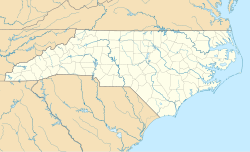Top Qs
Timeline
Chat
Perspective
Trinity Historic District
Historic district in North Carolina, United States From Wikipedia, the free encyclopedia
Remove ads
Trinity Historic District, also called Trinity Park, is a national historic district and residential area located near the East Campus of Duke University in Durham, North Carolina.[2] The district encompasses 751 contributing buildings in a predominantly residential section of Durham. They were built between the 1890s and 1960 and include notable examples of Queen Anne and Bungalow / American Craftsman style architecture. Located in the district are the separately listed "Faculty Row" cottages: the Bassett House, Cranford-Wannamaker House, Crowell House, and Pegram House. Other notable buildings include the George W. Watts School (1917), Julian S. Carr Junior High School (1922), Durham High School (1923), Durham Alliance Church (1927), Trinity Avenue Presbyterian Church (1925), Watts Street Baptist Church (1925), Great A & P Tea Company (1927–1929), Grace Lutheran Church (c. 1950), and the former Greek Orthodox Community Church (c. 1950).[3][4][5]
It was listed on the National Register of Historic Places in 1986, with a boundary increase in 2004 and 2008.[1]
Remove ads
Notable buildings
Notable residents
Notable current and former residents of Trinity Park include:
- John Spencer Bassett, Duke University professor
- Joseph Penn Breedlove, first librarian of Duke University
- John Franklin Crowell, Trinity College president
- William Preston Few, first president of Duke University
- George B. Pegram, Manhattan Project physicist
- Justin Tornow, dancer and choreographer
Gallery
- Joseph Penn Breedlove house (1915), 407 Watts St.
- Bassett-Brown house
- Cranford house
References
Wikiwand - on
Seamless Wikipedia browsing. On steroids.
Remove ads









